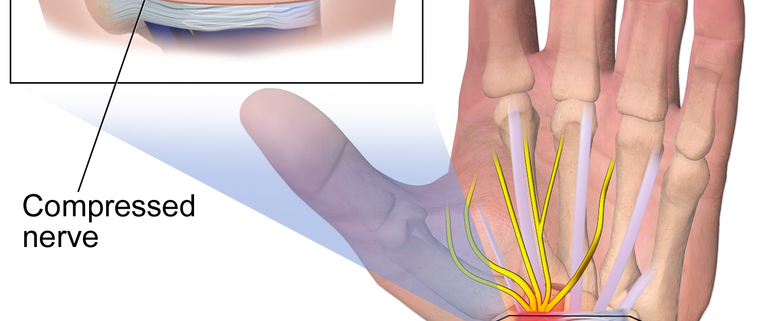
Carpal Tunnel Syndrome
Overview
Carpal tunnel syndrome (CTS) is a common condition that affects people from all walks of life. This condition affects the hand and arm, causing tingling, numbness, and pain. It’s caused by pressure on the major nerve that travels through the wrist, known as the median nerve. Recent statistics show that up to 5% of adults may be affected by CTS, with women being affected three times more often than men.
Types
While there aren’t typed or subtypes of CTS, the symptoms can vary in intensity and duration from person to person. Chronic carpal tunnel is the long-lasting form of the condition, while acute carpal tunnel may develop quickly, often due to a traumatic injury or sudden onset of symptoms.
Causes
CTS is often caused by conditions or activities that put pressure on the median nerve at the wrist. These can include:
-
- Certain health conditions such as diabetes, thyroid dysfunction, and rheumatoid arthritis.
-
- Repetitive hand motions, especially those involving vibrating tools.
-
- Pregnancy, due to hormonal changes and fluid retention.
-
- Wrist injuries and trauma.
Symptoms
Those affected by CTS commonly experience:
-
- Numbness, tingling, or burning in the thumb, index, and middle fingers.
-
- Hand weakness, making it difficult to grasp small objects or perform other manual tasks.
-
- Pain or tingling that may travel up the forearm towards the shoulder.
-
- Symptoms often worse at night or upon waking.
Less common symptoms may include a loss of hand coordination and hot-cold sensations in the hand.
Diagnosis
CTS is diagnosed through a series of procedures:
-
- Medical history: Your doctor will ask about your symptoms, health conditions and activities that could cause pressure on the median nerve.
-
- Physical examination: Your doctor may bend or tap on your wrist or have you grip something to check for signs of CTS.
-
- Nerve tests: These tests measure how your median nerve is working and can help determine if you have CTS.
-
- Imaging: In some cases, your doctor may order an MRI or ultrasound to see detailed images of your wrist.
Treatment Options
Treatment options for CTS typically depend on the severity of the symptoms.
-
- Non-surgical treatments: Can include wrist splinting, avoiding activities that worsen symptoms, and taking over-the-counter medication for relief of pain and inflammation.
-
- Physical therapy: Exercises and therapies like ultrasound or electrical nerve stimulation may be beneficial.
-
- Surgery: If symptoms are severe or worsening, or if non-surgical treatments have not helped, your doctor may recommend surgery to relieve pressure on the median nerve.
Living With Carpal Tunnel Syndrome
Managing CTS is often about making small changes to protect your wrist and hand. Tips for managing CTS include:
-
- Take regular breaks from repetitive activities.
-
- Stretch and flex your wrists regularly.
-
- Wear a wrist brace during activities that aggravate your symptoms.
-
- Try to keep your wrists neutral (not bent in either direction).
-
- Manage other health conditions that could contribute to CTS.
When to Seek Help
You should seek medical help if you have persistent symptoms of CTS that interfere with your normal activities and sleep patterns. Seek immediate medical help if you have sudden loss of sensation or strength in your hand or arm or if your symptoms are rapidly worsening. Early diagnosis and treatment are key to preventing long-term damage to the median nerve.
